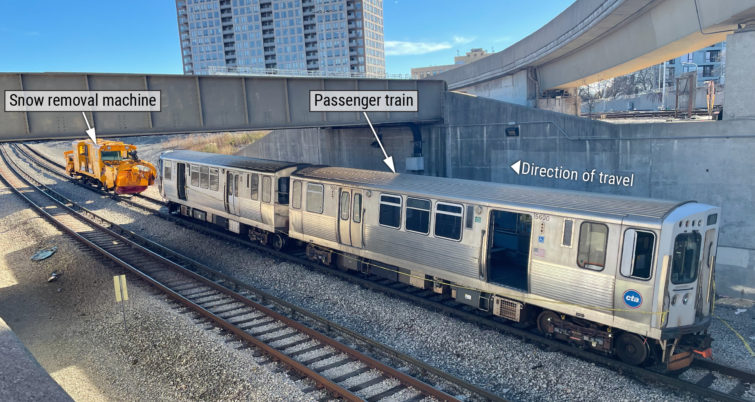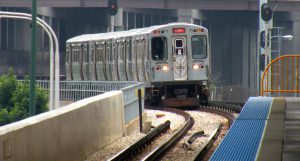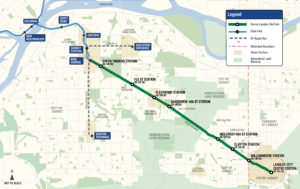NTSB Investigates CTA Yellow Line Train and Snow Removal Machine Collision
Written by Jennifer McLawhorn, Managing Editor
CHICAGO – The National Transportation Safety Board has released details on a collision between a Chicago Transit Authority Yellow Line train and a rail-bound snow removal machine.
The National Transportation Safety Board has released details on a collision between a Chicago Transit Authority Yellow Line train and a rail-bound snow removal machine. At around 10:30 a.m. on November 16th, a CTA Yellow Line passenger train was heading south when it collided with a stationary CTA snow removal machine (S-500) on the south Skokie track 1 and subsequently derailed. The passenger train is reported to have been carrying 1 operator and 30 passengers, and six CTA employees were aboard the snow removal machine. According to the NTSB, 16 people were treated at a hospital with three left critically injured. There were no fatalities. The Chicago Transit Authority estimates the cost of the damage to be around $8.7 million.
The train was scheduled to travel from Dempster Skokie Station to Howard Station. The report states that the operator knew the snow removal machine was operating on the Yellow Line but was not aware of its exact location. Before the collision occurred, the snow removal machine stopped 370 feet north of a red signal indication. Then, the operator of the southbound passenger train, which was travelling at about 54 mph, “received a stop command from the signal system because of the snow removal machine stopped on the track about 2,150 feet ahead.” Immediately after, the operator initiated a full-service braking application and then the emergency braking application after seeing the snow removal machine. Before striking the snow removal machine, the train was travelling at approximately 27 mph. The NTSB reports that a “preliminary review of the train’s event recorder showed that the wheel slide protection system activated throughout both braking applications.”
The track where the accident occurred is double main track, and movements are authorized by “wayside and in-cab signal indications with an overlaid automatic train control system and coordinated from a rail operations control center.” According to the report, the signal system is configured to allow a stopping distance of 1,780 feet or less with a maximum authorized speed of 55 mph, per CTA instructions.
Consisting of two 5000-series heavy rail transit vehicles from Bombardier Transportation in 2014, the railcars were designed according to CTA’s braking specifications, “meaning the deceleration rate, or brake rate, for a full-service braking application was about 4.1 feet per second squared under ideal conditions.” Additionally, the railcars had three types of brake systems: dynamic, friction, and magnetic track brakes. Each system can be activated by the train operator or the automatic train control system. The railcars were also equipped with a wheel slide protection system, according to the report.
NTSB investigators “conducted sight distance observations, reviewed data from the train’s event recorder as well as the inward- and outward-facing image recorders, reviewed communications from rail operations control, collected samples of organic material from the top surface of the rails at the accident site, and conducted interviews.” As of reporting, this investigation is still ongoing, and future investigation into this incident will focus on the “design and configuration of the CTA signal system, the design and braking performance of the railcars involved in the accident, and examination of organic material present on top of the running rails investigators collected to determine what impact, if any, this material had on the accident.”
On November 17th, the NTSB held a Media Brief in Chicago discussing the collision:
The following day, on the 18th, the NTSB released “B Roll – CTA Train Collision with Rail Equipment,” showing investigators walking the scene of the collision:
In response, the Chicago Transit Authority released a statement on December 12th on the NTSB preliminary report. The CTA stated it acknowledges the publication and appreciates the ongoing review and that it will “continue to work closely with the NTSB on its ongoing investigation of the incident. From the beginning, the CTA has been fully committed to assisting the NTSB investigation in any way possible. We continue to provide the agency full access to equipment, facilities, records, personnel and any other information it requests.
“The CTA is currently engaged in an extremely thorough review of all aspects of the Yellow Line mentioned in the NTSB preliminary report, from signals to tracks to equipment, as well as testing trains to ensure safe operation. These activities require time to perform, and once this review is complete, CTA will determine a plan to reopen. Safety continues to be our No. 1 consideration.”
Additionally, the CTA released a second statement at 4:30 p.m. on December 12th stating it is “fully committed to assisting the NTSB investigation in any way possible.” It will follow steps based on examination and testing listed below “to provide the highest level of safety.”
- Establishing a new maximum speed on the Yellow Line from 55 mph to 35 mph: By reducing the speed, the CTA hopes this will decrease the distance necessary for a train to stop and increase operator reaction time.
- Expanded cleaning of rails: The rails have been cleaned of any debris or accumulated residue or deposits to allow for more friction between the rails and the wheels.
- Implementing manual blocking for non-revenue vehicles, like snowplows and other work equipment: According to the CTA, manual blocking is an operational control protocol that requires railcars and non-revenue equipment to move only after receiving a verbal command from CTA’s control center. This ensures that railcar and equipment movements are monitored closely through human intervention and does not solely rely on automated systems.
- Rail operator information and awareness: Yellow, Red, and Purple Line train operators will receive a comprehensive overview of these safety enhancements in-person.
- Supervised trips: Now, Yellow Line train operators will be accompanied by CTA supervisors and managers for the first several trips when the Lien reopens. This will provide extra observation and guidance.
The CTA closed out their statement by saying that it is “currently engaged in an extremely thorough review of all aspects of the Yellow Line mentioned in the NTSB preliminary report, from signals to tracks to equipment, as well as testing trains to ensure safe operation. These activities require time to perform, and once this review is complete, CTA will determine a plan to reopen. Safety continues to be our No. 1 consideration, and reopening won’t occur until we have completed our thorough review. While testing continues, CTA continues to provide free shuttle buses for Yellow Line customers, connecting the Howard station and the two Skokie stations, Oakton-Skokie and Dempster-Skokie.”





